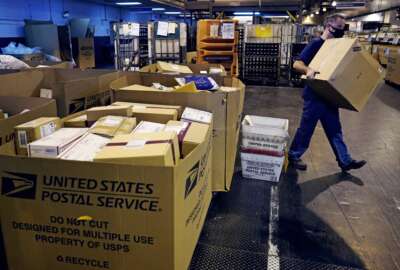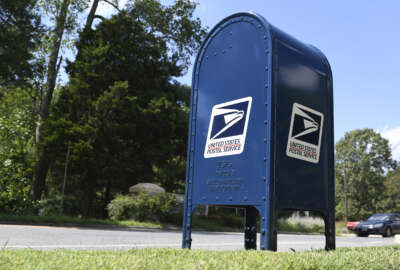
USPS outlines plan to address ‘dramatic escalation’ in letter carrier robberies
The Postal Service is working with its Postal Inspection Service on ways to address an uptick in robberies of letter carriers.
The Postal Service is moving ahead with a major shakeup of its delivery network this year as part of its 10-year reform plan.
Postmaster General Louis DeJoy told the USPS Board of Governors on Thursday that he is working with postal unions and management associations to accomplish a “remarkable turnaround endeavor,” as outlined in the agency’s 10-year reform plan.
Those turnaround efforts include USPS moving more of its delivery infrastructure to Sort and Delivery Centers (S&DCs) as well as the agency continuing to maximize its rate-setting authority, as permitted by the Postal Regulatory Commission.
DeJoy praised the USPS board for working hard to “understand the magnitude of the complications involved and then unwinding the many years of damage inflicted on this organization.”
However, DeJoy signaled that continued rate increases will likely continue until USPS revenue outpaces the rate of inflation. The price of a first-class stamp went up to 63 cents in January.
“Inflation reigns dominant in our cost structure and eliminates these gains we are making. Our efforts will continue, and in time, those positive results will be greater and offset the inflation that we expect to see in the future,” DeJoy said.
DeJoy said USPS under the plan is focused on five key areas: improving operational precision, improving service reliability, reducing costs, increasing revenue, and “creating productive and enjoyable long-term career paths for our employees.”
“This new emphasis on not only doing things right, but doing the right things, the things that a modern service organization needs to do to survive in a competitive environment, is beginning to create energy, focus, and improvement across every function of our entity,” he said.
DeJoy said USPS performance has largely stabilized since the start of the pandemic, and that 96% of the nation’s population is receiving mail in less than three days. While “service misses” occur, DeJoy said they are brief and resolved quickly.
“For those of you in the 4% areas, we are working hard to correct our service difficulties in your areas and will do so urgently,” DeJoy said.
USPS opened its first Sort and Delivery Center in Athens, Georgia, and expects to open an additional five S&DCs later this month.
DeJoy said the consolidation of the USPS delivery network is essential to the success of USPS rolling out a largely electric delivery vehicle fleet in the coming years.
“This new vehicle initiative, along with our major efforts to improve on network operating practices, will make the United States Postal Service a leader and carbon footprint reduction,” DeJoy said.
Board Chairman Roman Martinez IV said ongoing network modernization efforts are a significant part of the “three-legged stool” of reforms USPS has planned as part of its 10-year strategy.
USPS accomplished one major part of that reform with Congress passing the Postal Service Reform Act last year. Martinez said USPS is also looking to the Biden administration to restructure its contributions for postal employees under the Civil Service Retirement System (CSRS).
“Perhaps the most critical one is the one that we are embarking [on], reforming or restructuring our network and our business, to both enhance our revenue potential and to manage our costs, and an integral part of that is our investments,” Martinez said.
To underscore the severity of USPS’s financial challenges, Martinez said the agency deferred on $15-20 billion in capital investments over the past 10 years.
“We’re speeding ahead to catch up on that, because that is absolutely critical,” Martinez said.
DeJoy said USPS, under its 10-year reform plan, is modernizing its operations to reflect present-day business realities.
While he applauded USPS board members for implementing the plan, he urged other postal stakeholders, which include mailers and regulators, to also fall in line with the proposed changes.
“This is a new Postal Service, recognizing it’s a new day in a new economy, and we’re leading the way to improve this cherished institution from the destruction that started in 2006 — and we cannot move fast enough,” DeJoy said. “Unfortunately, there are some stakeholders stuck in the past as far as 2006, and I again ask that all stakeholders recognize the urgency we face in making the changes we are pursuing.”
USPS reported a $1 billion net loss for the first quarter, which covers the agency’s year-end peak holiday season. That’s an improvement, compared to a net loss of $1.5 billion for the same quarter last year.
USPS package revenue increased by $203 million, or 2.4%, despite a 3.5 % decrease in volume compared to the same period last year. USPS said the decline in package volume reflects a slowdown in the surge of e-commerce that began under the COVID-19 pandemic.
However, USPS package volume remains higher than pre-pandemic levels.
USPS saw first-class mail revenue increase by $95 million, or 1.5%, despite a volume decrease of 587 million pieces, or 4.5%, compared to the same quarter last year. First-class mail volume remains lower than pre-pandemic levels.
Governor Anton Hajjar said the agency’s strategy of converting non-career employees to career status throughout the year helped the agency make it through a busy year-end peak season, and “directly contributed to its success this past year.”
The strategy places greater reliance on having more full-time career employees on-hand for the peak season, and less reliance on the number of temporary employees.
“The USPS HR strategy of relying on career employees goes beyond peak season staffing, and the competition for workers in today’s labor market. USPS offers a good career with good pay and benefits, and the opportunity for advancement,” Hajjar said.
USPS converted more than 100,000 workers to full-time roles since the beginning of 2021, with more than 41,000 part-time workers converted to full-time since January 2022.
USPS board members are also looking to address an uptick in crime against postal employees.
Governor Ron Stroman, former deputy postmaster general, raised concerns about a “dramatic escalation” in robberies against letter carriers and a rise in mail theft.
“These trends continued over the recent holiday season and are now almost a daily occurrence,” Stroman said.
Criminals, he added, are robbing letter carriers for their arrow keys, which are used to open blue mail collection boxes. Criminals then use these arrow keys to steal mail and packages.
The USPS board met in June with the Postal Inspection Service (USPIS), which outlined its plans to address the rise in crime.
Its strategy includes deploying postal inspectors and analysts to high-crime areas and enhanced coordination with the Justice Department, as well as other federal and local law enforcement partners.
Stroman said USPS is partnering with USPIS to harden the security of mail receptacles and is looking to replace arrow keys with a new “arrow-less system.”
“I speak for everyone on the board and saying that we have no higher priority than the safety and well-being of the women and men of the United States Postal Service, and protecting our customers,” Stroman said.
Copyright © 2024 Federal News Network. All rights reserved. This website is not intended for users located within the European Economic Area.
Jory Heckman is a reporter at Federal News Network covering U.S. Postal Service, IRS, big data and technology issues.
Follow @jheckmanWFED
Related Stories

USPS operational changes aren’t putting rural delivery at disadvantage, watchdog finds




